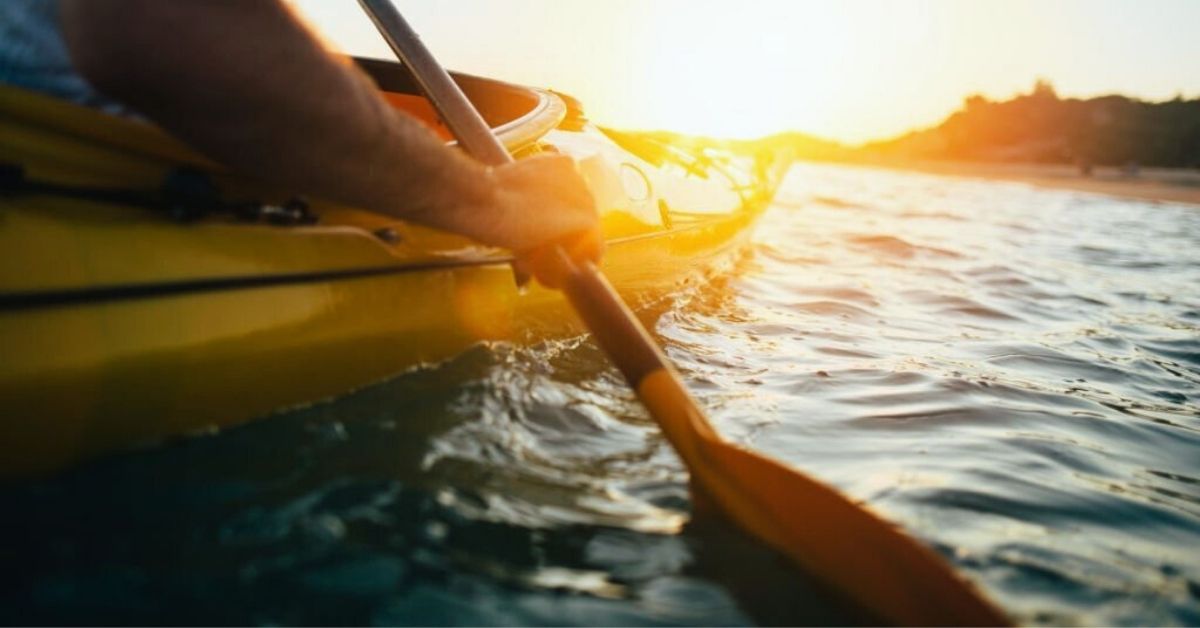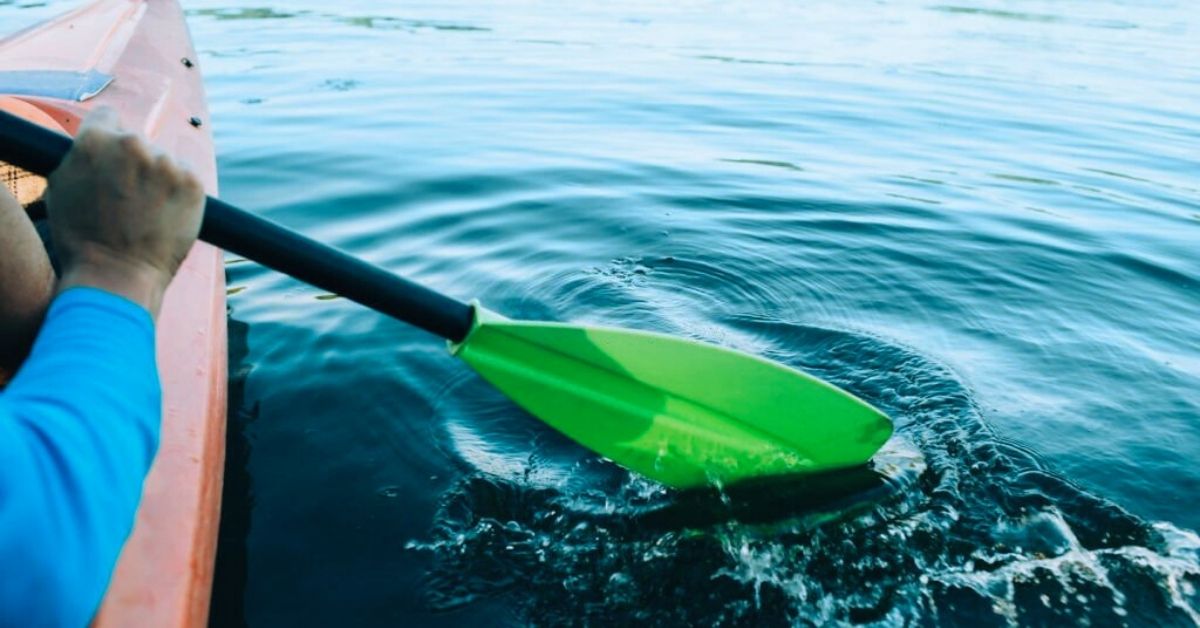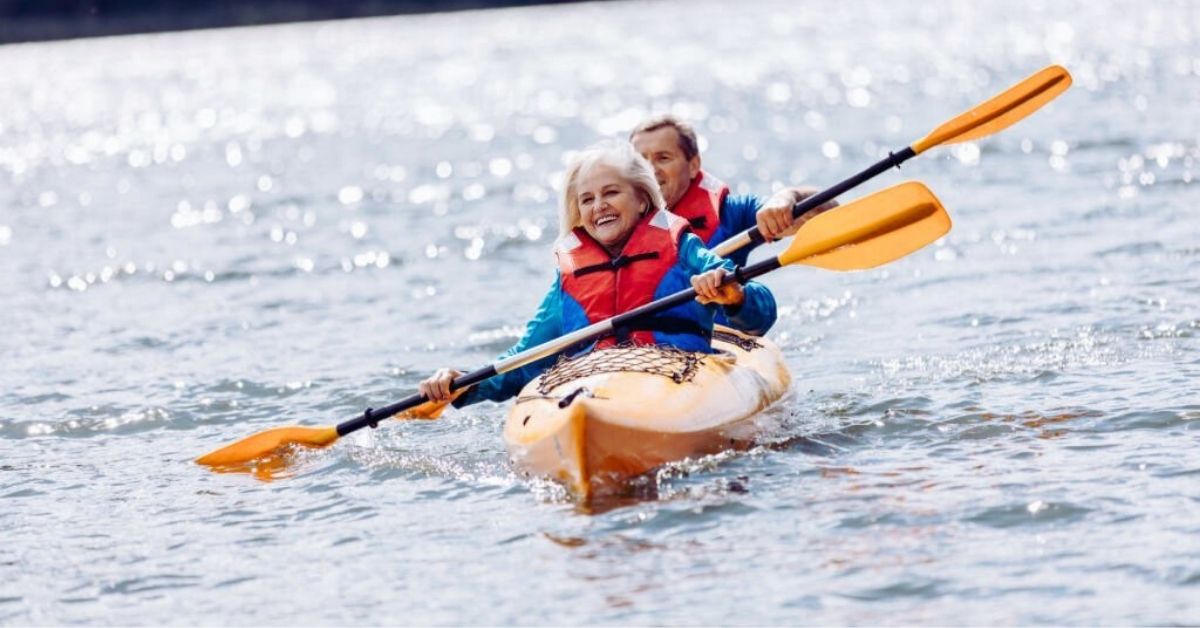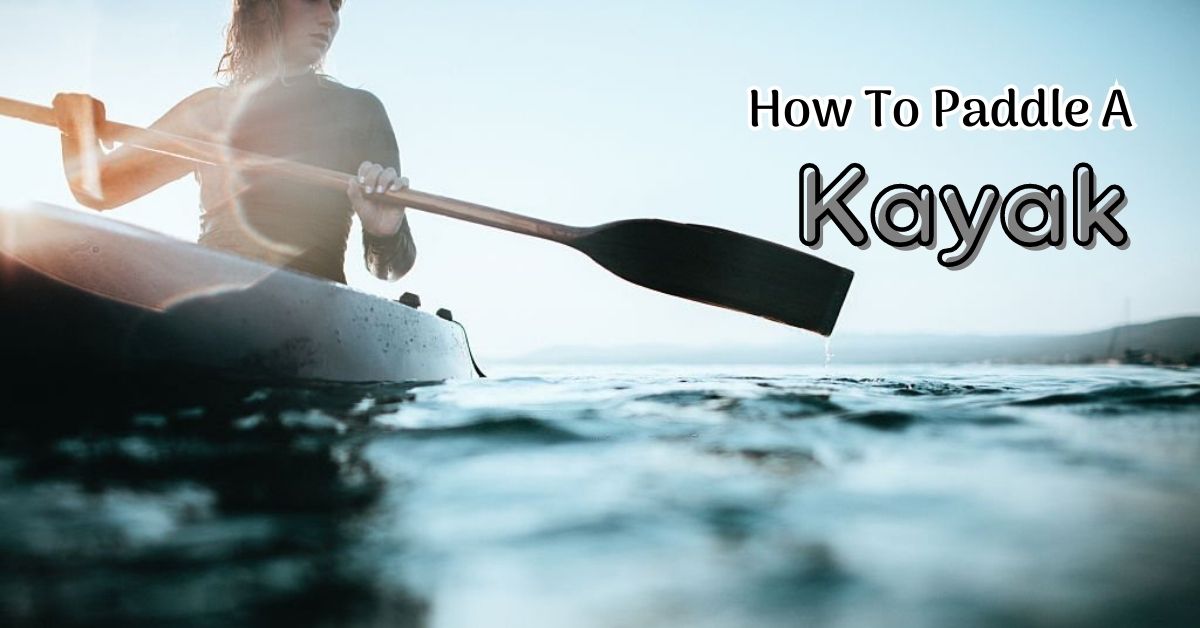Kayaking is a thrilling way to explore the outdoors, but you need the correct gear and abilities before you go.
Beginners may find kayaking intimidating, but with proper instruction and gear, anybody can paddle confidently.
We’ll cover everything from paddling basics and safety in our beginner’s guide to kayaking. Discover nature’s splendor from a different angle while feeling secure and prepared on the water. Grab your paddle and let’s begin!
Table of Contents
1. Why kayaking is a great outdoor activity for beginners
Kayaking is a thrilling outdoor sport that combines relaxation, adventure, and workout. Beginners who wish to discover nature and excitement on the water should try it. Kayaking is a fantastic introductory outdoor sport for these reasons:
1. Unlike other water sports, kayaking is simple to learn: Beginners may rapidly learn the basics and paddle competently with a few safety measures. Kayaking is a great introduction to physical activity for all ability levels.
2. Closeness to nature: Kayaking lets you experience nature like never before. As you paddle through tranquil rivers, lakes, or the sea, you’ll see stunning scenery, varied animals, and hidden jewels only accessible by water. It allows you to disconnect from the world and reconnect with nature.
3. Starting kayaking requires little equipment: Many kayak rental establishments provide basic kayaks, paddles, and safety gear. This allows newcomers to attempt the sport without buying pricey gear.
4. Physical fitness: Kayaking works the mind and body. Paddling works the arms, shoulders, back, and core. Low-impact exercise increases cardiovascular health, strength, and endurance. The tranquility of the water may also reduce stress and improve well-being.
5. Social and recreational: Kayaking may be done alone or with others. Exploring new seas with family and friends is a great way to connect. Many kayaking communities provide group trips, races, and other activities to meet like-minded people and make memories.
For novices, kayaking provides a variety of advantages, from excitement to relaxation. Kayaking is popular with outdoor lovers of all ages and backgrounds because to its cost, fitness benefits, simplicity of learning, and connection to nature. So take a paddle, embrace the water, and kayak an incredible experience.
2. Selecting the right kayak and Accessories
A safe and fun kayaking adventure requires the correct boat and gear. Beginners may not know where to start with so many possibilities. Let us help you through the process!
Consider your kayaking style first. Do you like paddling on quiet lakes and rivers? Or are you seeking whitewater thrills? Your intended usage will help restrict your choices.
Sit-on-top kayaks are popular for recreational kayaking. These kayaks are sturdy, simple to get in and out of, and perfect for fishing or sightseeing. If you want speed and control, a sit-inside kayak may be ideal. This kayak is for expert paddlers and has a lower center of gravity.

Next, evaluate kayak size and weight. Make sure the kayak fits you and your stuff. Finding a kayak that fits well and securely will improve your paddling experience.
Accessories
A life jacket (PFD) is essential gear. PFDs built for kayaking are more mobile and buoyant. Also, get a paddle that fits your height and style. Paddles made of carbon fiber or fiberglass are lightweight and robust.
A spray skirt to keep water out of your kayak, a dry bag to safeguard your valuables, and weather- and water-appropriate apparel are also important.
Finally, remember safety gear like whistles, signaling devices, and first aid kits. In emergencies, these supplies should always be on board.
Remember that picking the correct kayak and gear is about safety and personal taste. Take your time, investigate, and seek experts. Selecting the right gear can help you paddle confidently and enjoy kayaking.
3. Basic kayaking skills and safety
Before kayaking, beginners should learn fundamental practices and safety advice. These basic skills will improve your kayaking experience and secure your safety.
First and foremost, learn good paddling technique. Hold your paddle with both hands slightly wider than shoulder-width apart. Use your core and body to propel your paddling instead of your arms. This approach will improve paddling efficiency and reduce fatigue.
Navigation is another crucial part of kayaking. Turning, stopping, and navigating obstacles are crucial. To turn, paddle quickly on the opposite side of the direction you wish to travel.
Place your paddle perpendicular to the water and gently push to halt. Practising these movements in a controlled setting can improve your kayaking confidence and enjoyment.
Always prioritize kayaking safety. Make sure you have a correctly fitting PFD or life jacket before venturing out. Wear your PFD at all times on the water. Be mindful of weather and check for rocks, strong currents, and submerged things. Also, tell someone your kayaking route and approximate return time.
Finally, practice self-rescue in case of a capsize. The wet exit, when you securely quit the kayak while immersed in water, and the re-entry will improve your water safety.
By learning these kayaking basics and following safety rules, you’ll be ready to paddle confidently and enjoy the sea. Practice makes perfect, so focus on safety and skill development when kayaking.
4. Understanding different types of water bodies and their challenges
Understanding water types and their obstacles is crucial to safe and fun kayaking. Each water body has its own circumstances and barriers that kayakers must consider.
Beginners should start with quiet lakes and ponds for their tranquility. Sheltered water bodies make paddling easy with little currents and waves. It’s still vital to watch out for motorized boats and other watercraft using the region.
Moving on to rivers and streams, kayaking is thrilling. It’s important to know the possible drawbacks. River navigation may be difficult because to rapids, currents, and submerged rocks and trees. Beginners should start with slower rivers and work up to more difficult ones as they gain confidence.
Kayakers face various problems in coastal and open seas. Strong tides, shifting weather, and severe seas demand more expertise and experience. Beginners should practice in calmer seas before entering coastal waters.
Before setting out, check weather predictions and water conditions in addition to comprehending each water body’s limitations. Wind, rain, and temperature may affect kayaking safety.
Learning about diverse water bodies and their difficulties can help you kayak through any barriers. Always prioritize safety, and don’t be afraid to ask experienced kayakers or take expert training to improve your abilities.
5. Paddling techniques for efficient and effective kayaking
Beginners must master paddling methods to kayak efficiently. It will assist you navigate the seas, reduce physical strain, and improve your paddling efficiency.
Grip is a key skill. Hold the paddle slightly wider than shoulder-width apart for a solid yet comfortable grip. This improves control and prevents paddle slippage.
Next, check your posture. Hold your back straight and engage your core. This maintains stability and evenly distributes body weight, improving strokes and maneuverability.

Paddling requires using your body rather than your arms. Rotate your body and engage your abs as you reach forward with the paddle blade.
Put the paddle blade firmly in the water and draw it backward, keeping it close to the kayak’s hull. This method, called the “forward stroke,” uses greater muscle groups to produce power and propel you forward.
For steering and turning, the “sweep stroke” is typical. Put your paddle blade in the water and stretch out to the side. Use your body to sweep the paddle away from the kayak. This will generate a turning effect and enable seamless direction changes.
Choosing the Right Paddle Length and Type
When choosing a kayaking or canoeing paddle, consider length and kind. The paddler’s height and boat width dictate paddle length.
A short or lengthy paddle may be uncomfortable and inefficient. The desired application should also determine the paddle type.
Flatwater paddles are for placid waterways, whereas whitewater paddles are for rapids. Selecting the right paddle length and type may improve paddling and water safety.
Beginning kayakers may paddle comfortably, efficiently, and enjoyably by learning these paddling skills.
6. How to handle common challenges on the water, such as wind and waves
Kayakers may face obstacles that test their abilities and confidence on the water. Wind and waves are a major obstacle for kayakers. Knowing how to manage these situations is essential for safe and fun kayaking.
Before leaving, check the wind direction and severity. Plan your approach by checking the weather prediction and knowing how it affects water conditions. To minimize exhaustion and delayed progress, change your route or schedule to avoid severe headwinds.
Paddle efficiently with a low stroke in heavy gusts. Keep your paddle close to the water and use short, forceful strokes to stay stable. By shifting your weight slightly toward the wind, you can neutralize the force and maintain your kayak on track.
Large or rough waves might also be difficult. Balance and stability are necessary for wave navigation. Relax and focus yourself in the kayak utilizing your core muscles.
Lean forward as you approach a wave to help your kayak ride it smoothly. Avoid paddling into waves to avoid swamping or capsizing. Instead, paddle at a “diagonal” or “45-degree angle,” which helps you manage waves.
In difficult wave conditions, keep a steady pace and prevent unexpected moves. Staying cool and attentive will help you manage unforeseen events. Take time to practice in diverse water and weather situations to gain confidence and become a better kayaker.
Beginner kayakers may paddle safely and skillfully by knowing how to manage wind and waves. Always emphasize safety, keep watchful, and ask experienced kayakers or experts for help.
7. Essential kayaking safety measures
Always prioritize kayaking safety. This thrilling water activity may take you to beautiful rivers and give fantastic experiences, but you must take safety measures.
First and foremost, wear a PFD. A PFD may save your life in an accident or capsizing, regardless of your swimming ability or water serenity. Before entering the water, check your PFD fit and fastening.

Knowing the kayaking environment is another safety step. Before kayaking, investigate the waterway’s risks, currents, and weather. Knowing the environment will help you plan your itinerary and make smart water selections.
NEVER underestimate the power of good gear. Maintain your kayak without leaks or damage. Make sure your paddles are secure and operating. For emergencies, include a waterproof map, compass, and whistle for a long journey.
Hydration and weatherproofing are also important. Keep water and sunscreen on hand to avoid dehydration and sunburn. Choosing the right clothes and shoes helps keep you comfortable and prevent injury from sharp rocks or submerged obstructions.
Finally, avoid kayaking alone. Having a companion or joining a group may provide safety and support in unexpected situations. You should also tell someone trustworthy about your kayaking route and return time.
Follow these safety measures to kayak confidently and enjoy the sport while keeping your safety and well-being in mind. Always put safety first to enjoy kayaking’s thrills.
8. What to pack for a kayaking trip and tips for eating on the water
To guarantee a safe and fun kayaking excursion, carry the correct gear. Here are some essential kayaking gear:
• Any kayaker, regardless of ability level, needs a PFD. It buoys and may save lives in an accident or capsize.
• Choose a paddle that fits your length and weight. Performance is best with lightweight, durable materials like carbon fiber or fiberglass.
• Waterproof or dry bags safeguard your things from water splashes and capsizing. These waterproof bags can hold your phone, wallet, keys, and other belongings.
• Staying hydrated is essential throughout any physical exercise, including kayaking. Keep hydrated on your travel with adequate water. Bring lightweight, non-perishable food to stay energized on the water.
• Sun protection: Wear a wide-brimmed hat, sunglasses, and high-SPF sunscreen. Lightweight, moisture-wicking apparel keeps you cool and protects your skin.
Let’s talk waterside dining recommendations. Kayaking requires good nutrition, but it might be difficult. These tips will make dining on the sea easier:
• Choose portable snacks and meals for kayaking. Granola bars, trail mix, and sandwiches are portable.
• Use resealable food containers: Buy leak-proof containers. This prevents spills and leaks, keeping your kayak clean and food fresh.
• If you want to prepare a hot meal while kayaking, lightweight camping stoves or grills are perfect. Just observe safety procedures and local open fire laws.
• Bring lots of water to remain hydrated while eating. Hydrate during your vacation to maintain energy and health.
By being prepared and bringing the correct materials, you may enjoy your kayaking journey while keeping fed and comfortable.
9. Tips for improving your kayaking abilities
Congratulations for starting your kayaking confidence! After learning the fundamentals, explore resources and improve your kayaking abilities.
1. Kayak Club or Group
Joining a kayaking club is a great way to develop your abilities. These communities are full with experienced paddlers keen to share their knowledge. You’ll learn new skills and safety advice and go on group expeditions to explore other rivers.
2. Course in Kayaking
Consider taking a kayaking course for expert tuition geared to your ability level. Advanced paddling, rescue, navigation, and more are covered in beginner courses.
Outdoor centers and adventure schools provide these courses, guaranteeing you get adequate instruction and practice under expert instructors.
3. Learn using Books and Videos
Books, online courses, and instructional videos may help you improve your kayaking abilities. Improve advanced strokes, rolling skills, or whitewater kayaking with targeted materials. These tools provide insights and visuals to improve your comprehension and performance.
4. Attend kayaking events or workshops
Attend local kayaking seminars or activities. Learn from the best at these events with professional speakers, demonstrations, and hands-on workshops. It’s a great chance to meet other kayakers, learn new skills, and network.
5. Practice, Practice, Practice
The key to improving your kayaking abilities is practice. Apply your skills in real life, try various water conditions, and progressively push your boundaries. Regular practice will boost your confidence and improve your kayaking abilities.
Remember, kayaking is lifelong learning. Take advantage of chances to learn, consult with experienced paddlers, and keep trying new things. With commitment and enthusiasm, you’ll become a confident kayaker quickly.
